|
PLACES TO SEE/VISIT - RAJASTHAN
Ajmer/
Pushkar
Bikaner
Jodhpur
Mount Abu
Sawai
Madhopur
Bharatpur
Chittorgarh
Jaisalmer
Udaipur
Ajmer/ Pushkar: Ajmer is
one of the most significant pilgrimate destination equally
important for Hindus as well as Muslims. Especially famous is
the Dargah Sharif-tomb of the Sufi saint Khwaja Moinuddin
Chisti.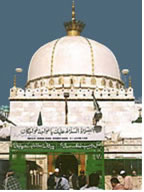
Ajmer is very close to Pushkar (11 kms) which is significant
for the famous fair held normally in the month of October/November.Pushkar,
the abode of Lord Brahma,lying to its west with a temple and a
picturesque lake.The Pushkar lake is a sacred spot for Hindus.
During the month of Kartik(Oct./Nov.),devotes throng in large
numbers here to take a dip in the sacred lake.
Place to see in and around Ajmer:-
The Dargah
Shahjhans Mosque
Adhai-din-ka-jhonpra
Taragarh Fort
The Museum
Mayo College
Pushkar Lake (11km.)
Man Mahal
Foy Sagar(5km)
top
Bikaner : The royal fortified
city with a timeless appeal. Lying in the north of the desert
state, the city is dotted with many sand dunes.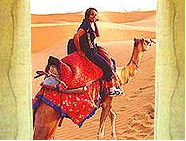 Bikaner retains the medieval splendor that pervades the citys
lifestyle. More popularly called the camel country , the city
is renowned for the best riding camels in the world. The ship
of the desert is an inseparable part of life here. Be it
pulling heavy carts , transporting grains or working on wells,
camels are the prime helpers.The wells of Bikaner: an
important source of water are other attractions of the city.
These are built on high plinths with slender minareted towers
on each of the four corners and can be noticed even from a
distance.
Bikaner retains the medieval splendor that pervades the citys
lifestyle. More popularly called the camel country , the city
is renowned for the best riding camels in the world. The ship
of the desert is an inseparable part of life here. Be it
pulling heavy carts , transporting grains or working on wells,
camels are the prime helpers.The wells of Bikaner: an
important source of water are other attractions of the city.
These are built on high plinths with slender minareted towers
on each of the four corners and can be noticed even from a
distance.
Place to see in and around Bikaner:-
Junagarh
Lal Garh Palace
The Suraj Pol or Sun Gate
Ganga Golden Jubilee Museum
Gardens and Parks
Bhandasar Jain Temple (5 km)
Camel Research Farm (8 km)
Devi Kund (8 km)
Gajner Wildlife Sanctuary (32 km)
Shiv Bari Temple(6 km)
top
Jodhpur :
Amidst the sand dunes and thorny vegetation of Thar desert
towers a fort, 120 metres above the plain. The fort overlooks
the imperial city of Jodhpur, which is a part of the Desert
Tourist Triangle.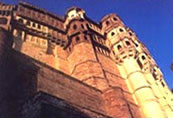 The old Jodhpur city is surrounded by a 10 km long wall with
eight gates serving as entrances. The new city is settled
around this walled area. The Maruthal or 'land of death' ,
came into life when the Rathores of Kanauj moved in. But the
city of Jodhpur was founded by Rao Jodhaji in 1459 AD. This
city was on the silk route of the 16th century and hence was
host to a number of travellers.
The old Jodhpur city is surrounded by a 10 km long wall with
eight gates serving as entrances. The new city is settled
around this walled area. The Maruthal or 'land of death' ,
came into life when the Rathores of Kanauj moved in. But the
city of Jodhpur was founded by Rao Jodhaji in 1459 AD. This
city was on the silk route of the 16th century and hence was
host to a number of travellers.
In Jodhpur, the genius of its sculptors comes to life in its
exquisite palaces, forts, temples and havelis, which stand
testimony to the imperial grandeur. The most alluring part of
Jodhpur is the traditional lifestyle, festivity and the
smiling people who treasure this former princely state.
Place to see in and around Jodhpur:-
Mehrangarh Fort
Jaswant Thada
Umaid Bhawan Palace
Government Museum
Girdikot and Sardar Market
Maha Mandir Temple
Balsamand Lake and Gardens (5 km)
Mandore(8 km)
Mahamandir Temple (9 km)
Kailana Lake (11 km)
Osian (58 km)
top
Mount Abu : The
only hill station in Rajasthan, Mount Abu is more than just a
summer retreat.
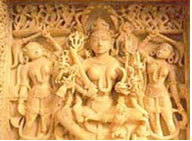 Its
stunning array of exquisite Dilwara Jain Temples, dating back
11th- 13th centuries, make it a popular pilgrimage centre.
Abu according to a legend.stands for the son of Himalayan,
deriving its name from Arbuada,the powerful serpent who
rescued Nandi, the sacred bull of Lord Shiva, from a chasm. Its
stunning array of exquisite Dilwara Jain Temples, dating back
11th- 13th centuries, make it a popular pilgrimage centre.
Abu according to a legend.stands for the son of Himalayan,
deriving its name from Arbuada,the powerful serpent who
rescued Nandi, the sacred bull of Lord Shiva, from a chasm.
Situated at the southern tip of the Aravali range the hill
retreat owes its cool climate to its rich flora covering the
entire hillside that includes coniferous trees and flowering
shrubs. The road leading to Mount Abu is a curved one
characterized by arid region dotted with huge rocks in weird
shapes and high velocity winds.
Place to see in and around Mount Abu:-
Gaumukh Temple
Delwara Jain Temple
Adhar Devi Temple
Sunset Point
Honeymoon Point (Andra Point)
Shri Raghunathji Temple
Gardens and Parks
Museum and Art Gallery
Trevors Tank (5 km)
Achalgarh (8 km)
Guru Shikhar (15 km)
top
Sawai Madhopur : Lying
on the main Delhi - Mumbai railway line, Sawai Madhopur is the
gateway to the world renowned Ranthambhore National Park - the
famous Tiger Reserve, just 12 kms away from here. Ranthambhore has been a witness to the rise and fall of many
rulers and a series of battle scenes.
Ranthambhore has been a witness to the rise and fall of many
rulers and a series of battle scenes.
In the 13th century A.D., Govinda, the grandson of Prithviraj
Chauhan took over the reign of the land. Later his successor
Vagbhatta beautified the city and built a noteworthy temple at
Jhain.
In the middle of 15th century A.D., Rana Kumbha captured the
fort and gifted it to his son to be occupied later by the Hada
Rajputs of Bundi and Mughal Emperors Akbar and Aurangazeb.
Mughal emperor Shah Alam gifted it to Maharaja Sawai Madho
Singh 1 of Jaipur in 1754 and since then it was mainted as the
hunting preserve of the Maharaja Sawai Madho Singh. Queen
Elizabeth II and the Duke of Edinburgh were part of the royal
hunting parties who stayed here.
Place to see in and around Sawai Madhopur:-
Ranthambore National Park
Ranthambore Fort
Jogi Mahal
top
Bharatpur :
Bharatpur is considered as the Eastern Gateway to Rajasthan.
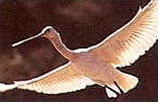 Bharatpur
is popular for its bird sanctuary-the Keoladeo Ghana National
Park - finest in Asia rich avian variety. Every year the rare
Siberian cranes come to spend the winter in the warmer climate
of Bharatpur. Bharatpur
is popular for its bird sanctuary-the Keoladeo Ghana National
Park - finest in Asia rich avian variety. Every year the rare
Siberian cranes come to spend the winter in the warmer climate
of Bharatpur.
Of the remnants of the royal past remains the marvellous
Bharatpur Palace housing a rich repository of a large number
of ancient exhibit that date back to the early 15th century.
Place to see in and around Bharatpur:-
Keoladeo National Park
Lohagarh Fort
Government Museum
Jawahar Burj and Fateh Burj
The Palace
Deeg(32 km)
top
Chittorgarh : Chittaurgarh
exhibits the pride and glory of Rajasthan in the form of its
various forts and monuments.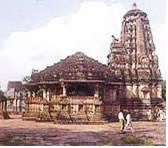 It is a ruined citadel where the royal past lives in the
imposing forts, graceful palaces and spectacular chhatris. The
entire city echoes with the tales of romance and valor unique
to the Rajput tradition.
It is a ruined citadel where the royal past lives in the
imposing forts, graceful palaces and spectacular chhatris. The
entire city echoes with the tales of romance and valor unique
to the Rajput tradition.
The antiquity of Chittaurgarh is difficult to trace, but it is
believed that Bhim the legendary figure of the Mahabharta,
visited this place to learn the secrets of immortality and
became the disciple of a sage, but his impatience to perform
all the rites deprived him of his goal, and out of sheer anger
he stamped on ground creating water reservoir, this reservoir
is called as Bhim Lat. Later on, it came under the Mauryas or
Muri Rajputs, there are different opinions as to when ilt came
under the Mewar ruler, but it remained the capital of Mewar
till 1568, when it was shifted to Udaipur.
Place to see in and around Chittaurgarh :-
The Fort
Vijay Stambh or 'Victory Tower'
Kirti Stambh or 'Tower of Fame'
Rana Kumbha's Palace
Padmini Palace
Meera Bai Temple
Kumbha Shyam Temple
Kalika Mata Temple
Jaimal and Patta's Palace
Government Museum
Gaumukh (Cow's mouth Reservoir)
Mohar Magri (Hill of Gold Coins)
Fateh Prakash Museum
Bassi Wildlife Sanctuary
top
Jaisalmer : The city has an
interesting legend associated with it, according to which,
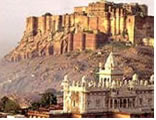 Lord
Krishna- the head of Yadav clan foretold Arjuna that a remote
descendent of the Yadav clan would build his kingdom atop the
Trikuta Hill, His prophecy was fulfilled in 1156AD. When Rawal
Jaisal, a Bhatti Rajput abandoned his fort at Lodurva and
founded a new capital Jaisalmer, perched on the Trikuta Hill.
Bhatti Rajputs of Jaisalmer were fedual chief who lived off
the forced levy on the caravans laden with precious silks and
spices that crossed the territory enroute Delhi-or Sind. Lord
Krishna- the head of Yadav clan foretold Arjuna that a remote
descendent of the Yadav clan would build his kingdom atop the
Trikuta Hill, His prophecy was fulfilled in 1156AD. When Rawal
Jaisal, a Bhatti Rajput abandoned his fort at Lodurva and
founded a new capital Jaisalmer, perched on the Trikuta Hill.
Bhatti Rajputs of Jaisalmer were fedual chief who lived off
the forced levy on the caravans laden with precious silks and
spices that crossed the territory enroute Delhi-or Sind.
Place to see in and around Jaisalmer:-
The Fort
Manak Chowk and Havelis
Gadsisar Lake
Tazia Tower
Havelis
Nathmalji-ki-Haveli
Patwon -ki-Haveli
Salim Singh-ki-Haveli
Jain Temple
Gyan Bhandar or Library
Lodurva (16 km)
Wood Fossil Park, Aakal(17 kms)
Sam Sand Dunes(42 km)
Desert National Park (45 km)
top
Udaipur : The city was founded
in 1567 AD by Maharana Udai Singh on the advice of a sage.
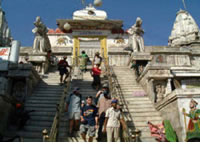 Udaipur
was last of the numerous Mewar capitals. It was in Udaipur
that legendary Maharana Pratap was born. He was obsessed with
Chittaur and the past glories of the Sisodia clan possessed
his mind. Maharana Pratap left Udaipur to win back Chittaur
from the Mughals. But he failed in his attempts and Udaipur
remained the capital of Mewar till India got her
independence.The memory of the failure of noble Pratap gives
Udaipur its pervading mood of nostalgic wistfulness. Udaipur
was last of the numerous Mewar capitals. It was in Udaipur
that legendary Maharana Pratap was born. He was obsessed with
Chittaur and the past glories of the Sisodia clan possessed
his mind. Maharana Pratap left Udaipur to win back Chittaur
from the Mughals. But he failed in his attempts and Udaipur
remained the capital of Mewar till India got her
independence.The memory of the failure of noble Pratap gives
Udaipur its pervading mood of nostalgic wistfulness.
Place to see in and around Udaipur:-
City Palace
Jagdish Temple
Saheliyon-ki-Bari
Pratap Memorial/Moti Magri
Pichhola Lake
Sajjan Garh
Fateh Sagar
The Suraj Gokhada
Bharatiya Lok Kala Mandir
Ahar
Gulab Bagh
Eklingji (22 km)
Ranakpur (90 km)
Nagda (23 km)
Haldighati (40 km)
Nathdwara (48 km)
Kankroli (65 km)
Rajsamand Lake (66 km)
Kumbhalgarh Fort ( 84 km)
Jagat (58 km)
Jaisamand Lake (48 km)
top
|






